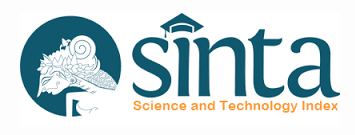PEMIKIRAN POLITIK ISLAM PADA MASA PEMERINTAHAN DINASTI ABBASIYAH
Abstract
This study discusses about the background of a transition of Umaiyah dynasty to Abbasiyah dynasty, The project role of Abbsiyah khalifah to get eventually the highest achievement in its time, and the things make Abbasiyah dynasty is ruined. This study is aimed to know the background of a transition from Umaiyah dynasty to Abbasiyah dynasty, to ascertain the project role of Abbsiyah khalifah to get the highest achievement in its time at last, and to find out the things make Abbasiyah dynasty is falled apart. The type of the research is a descriptive qualitative done through a documentation study. Data collected through documentation, using library research. Sources of data obtained through primary data and secondary data. The data obtained are then processed with an inductive method by clarifying the formal object of the research from general to specific.The outcome of this study points out that The transition of Bani Umayyah to Abbsiyah dynasty takes place as political movements when Bani Hasyim demands the Islam leader must be in their hands which is due to they are the closed prophet Muhammad’s relatives. The era of Daulah Abbasiyah is the golden age of Islam where the sovereignity of Islam is about in the top either in wealth, advancement, or authority. In the era of Abbasiyah, there is a lesson that can be learned which is Islam people do not to be distracted by the world power because that thing and luxury living cause a part from Allah swt’s teachings.
References
Abu Zahra, Imam Muhammad. Tarikh al-Jadl, cet I, t.tp : Dar al-Fikr al-‘Arabi, 1934
Amin, Ahmad amin, Dhuha al-Islam, jilid I, Kairo : Lajnah al-Ta’lif wa al-Tarjamah wa al-Nasyr, t.th
Departemen Pendidikan dan kebudayaan, Kamus Besar Bahasa Indonesia, cet. 3 (Jakarta : Balai Pustaka, 1990
Dewan Ensiklopedi Islam, Ensiklopedi Islam, jilid I, cet 9 ( Jakarta : PT Icchtiar Van Hoeve, 2001.
Fachruddin,Fuad Mohd, Perkembangan Kebudayaan Islam, cet. I, Jakarta : P.T.Bulan Bintang, 1985.
Hitti, Philip K, History of Arabs, diterjemahkan oleh R Cecep Lukman Yasin dan Dedi Slamet Riyadi, cet 2 (Jakarta : PT Serambi Ilmu Semesta, 2006.
Lapidus,Ira M, Sejarah Sosial Ummat Islam, Bagian satu & dua, cet I, Jakarta : PT. Raja Grafindo Persada, 1999.
Majid, Nurchalish, Khazanah Intelektual Islam, Jakarta : Bulan Bintang, 1984
Mufrodi, Ali, Islam di Kawasan Kebudayyan Arab, cet. I, Jakarta : Logos Wacana Ilmu, 1417 H/1997 M.
Nasution, Harun, Islam Ditinjau Dari Berbagai Aspeknya, jilid I,(Jakarta : Universitas Indonesia Press, 1394 H/1974 M
Syalaby, Ahmad, Mausu’ah al-Tarikh al-Islamiy wa al-Hadarah al-Islamiyah, juz 3, cet. 7, Kairo : Maktabah al-Nahdah al-Misriyah, 1982
Al-Suyuthi, Al-Hafidz Jalaluddin al-Suyuthi, Tarikh al-Khulafa’, Beirut-Lubnan : Dar al-Fikr, t.th.
Sunanto,Musyrifah, Sejarah Islam Klasik Perkembangan Ilmu Pengetahuan Islam, cet. I, Jakarta : Prenada Media, 2003
Al-‘Usaymi, Ahmad, al-Tarikh al-Islamiy, diterjemahkanoleh Samson Rahman dengan judul Sejarah Islam, cet.6, Jakarta : Akbar Media Eka Sarana, 1429 H / 2003 M.
Al-Usymawy, Muhammad Sa’id, al-Khilafah al-Islamiyah, cet III al-Qahira : Maktabah Madbuly al-Saghir, 1416 H/1996 M.
W. Montogomery Watt, Kejayaan Islam : Kajian Kritis dari Tokoh Orientalis, Yogyakarta : Tiara Winaca Yogya, 1990.
Watt, William Montgomery, Islam, A Short History, dialih bahasakan oleh Imron Rosjadi dengan judul Islam,, cet. I, Jakarta : Penerbit Jendela, 2002.
-------------------, Islam dan Peradaban Dunia; Pengaruh Islam atas Erofa Abad Pertengahan, dalam Suwito, Sejarah Sosial Pendidikan Islam, Ed. I, cet I Jakarta : Prenada Media, 2005
Yatim, Badri, Sejarah Peradaban Islam, Dirasah Islamiyah II, ed I, Jakarta : PT. Raja Grafindo Persada, 2007.
Once an article was published in the journal, the author(s) are:
granted to the journal right licensed under Creative Commons License Attribution that allows others to share the work with an acknowledgment of the work's authorship. permitted to publish their work online in third parties as it can lead to wider dissemination of the work. continue to be the copyright owner and allow the journal to publish the article with the CC BY license receiving a DOI (Digital Object Identifier) of the work.





